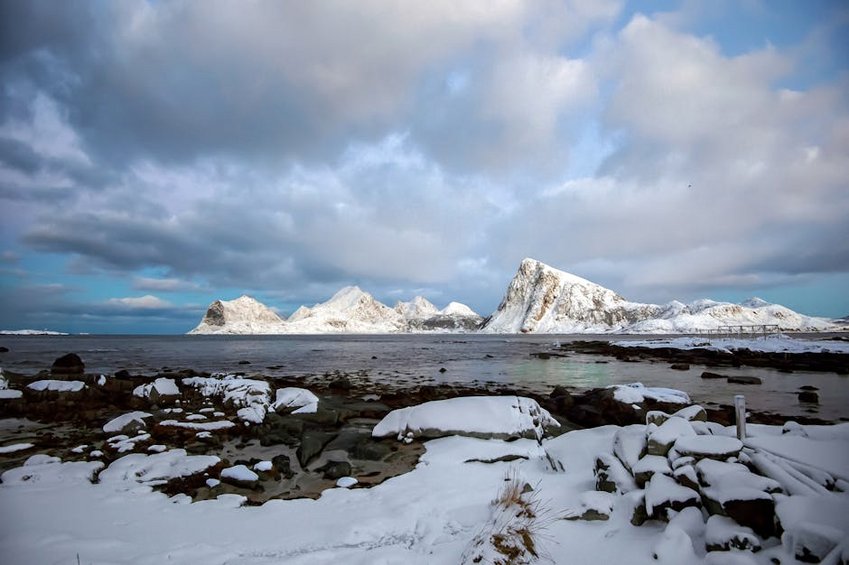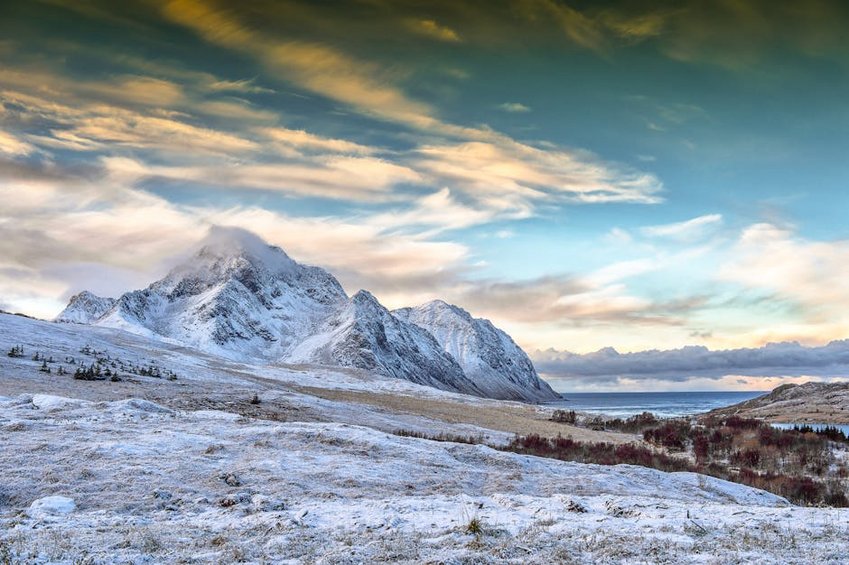Norway Lofoten Islands Winter Photography: Arctic Light Mastery
Norway Lofoten Islands winter photography captures the Arctic’s dramatic interplay of mountains, sea, and celestial light during the colder months. You’ll discover unique conditions where the aurora borealis dances over frozen fjords and the blue hour lingers for hours. This guide details optimal seasons, essential gear, and prime locations to maximize your photographic success in this remote archipelago.
Essential Information – Lofoten Islands
The Lofoten archipelago lies entirely within the Arctic Circle off Norway’s northwest coast, featuring steep peaks rising directly from the Norwegian Sea. Winter brings polar nights from early December to early January, with limited daylight but extended twilight periods ideal for photography. Temperatures typically range from 25°F to 35°F (-4°C to 2°C), though wind chill can make it feel significantly colder.
Historically, Lofoten’s economy centered on cod fisheries, with traditional rorbuer cabins dotting the coastline since Viking times. The islands’ cultural heritage blends Sami influences with Norwegian coastal traditions, visible in local museums and architecture. This rich history provides compelling subjects beyond landscapes, including fishing villages and historical sites.
Geography and Climate
Lofoten’s geography creates microclimates where weather changes rapidly within short distances. The Gulf Stream moderates temperatures, preventing extreme cold but bringing high humidity and precipitation. Snow coverage varies annually, typically accumulating from November through March.
- Mountain ranges like the Lofoten Wall create dramatic backdrops, with elevations reaching 3,000 feet in areas like Higravstinden.
- Coastal areas feature white-sand beaches such as Haukland and Utakleiv, which freeze into surreal ice formations during winter.
- Fjords and sheltered bays like Reinefjorden offer calmer conditions for reflection shots and Northern Lights photography.
- Budget option: $1,500-$2,500 per person for 7 days, staying in hostels or shared rorbuer, self-catering meals, rental car sharing, and minimal guided tours. Focus on public transportation and free locations like beaches and villages.
- Mid-range option: $3,000-$5,000 per person for 7 days, including private rorbuer accommodations, restaurant meals, rental car, and 2-3 guided photography tours. Balance independent exploration with expert guidance for optimal shots.
- Luxury option: $6,000-$10,000+ per person for 7 days, featuring premium hotels, private guides, specialized workshops, helicopter tours, and high-end gear rental. Maximize unique access and comfort in challenging conditions.
- Official Norway Tourism Board
- Lonely Planet Lofoten Islands Guide
Historical and Cultural Context
Lofoten’s fishing heritage dates back over 1,000 years, with stockfish production remaining economically important today. Traditional red rorbuer cabins originally housed seasonal fishermen and now serve as tourist accommodations. Several museums preserve this history, including the Lofoten Museum in Kabelvåg and the Viking Museum in Borg.
Contemporary culture maintains strong connections to the sea through festivals like the Lofoten International Art Festival. Local artisans create wool products from native sheep breeds, ideal souvenirs documenting traditional crafts. Respectful photography should always ask permission before photographing people or private property.
Why Lofoten for Winter Photography?
Lofoten offers unique Arctic light conditions with extended blue and golden hours during winter months. The aurora borealis appears frequently from September through April, with peak visibility during clear, dark nights. Minimal light pollution outside small villages creates exceptional astrophotography opportunities.
Diverse landscapes within compact areas let photographers capture mountains, beaches, and fishing villages in single sessions. The midnight sun occurs from late May to mid-July, but winter provides more dramatic lighting contrasts. Professional workshops operate throughout the season, offering guided access to remote locations.
Planning Your Norway Lofoten Islands Winter Photography Trip
Successful Arctic photography requires meticulous preparation for weather, light conditions, and logistical challenges. Book flights and accommodations three to six months in advance, especially for popular periods around equinoxes. Research ferry schedules and road conditions, as winter weather can disrupt transportation.
Create a flexible itinerary that accounts for variable weather, with backup locations for cloudy days. Pack redundant camera equipment and protective gear for sub-freezing temperatures. Consider joining guided tours for remote area access and local knowledge.
Best Time to Visit for Photography
February and March offer the best balance for Norway Lofoten Islands winter photography, with increasing daylight and frequent aurora activity. Daylight extends from approximately 8 AM to 4 PM, providing more shooting time than deep winter. Temperatures average 28°F to 34°F (-2°C to 1°C) with relatively stable weather patterns.
September and October provide autumn colors with early Northern Lights possibilities, though days shorten rapidly. December and January feature polar nights with only 2-4 hours of twilight, challenging for landscape work but excellent for aurora. Avoid November’s heavy precipitation and limited daylight.
Budget Planning and Costs
Photography trips to Lofoten require careful budget allocation across transportation, accommodation, and gear.
Essential Preparation Checklist
Camera gear must withstand Arctic conditions with multiple batteries, memory cards, and protective covers. Bring a sturdy tripod, wide-angle lenses (14-24mm), telephoto lenses (70-200mm), and polarizing filters. Pack lens cloths and airtight bags to prevent condensation when moving between temperatures.
Personal gear requires thermal layers, waterproof outer shells, insulated boots, and hand warmers. Research visa requirements (none for US/EU citizens for up to 90 days), purchase travel insurance with gear coverage, and download offline maps. Book ferries and rental vehicles early, especially for popular photography locations.

Top Attractions and Activities
Lofoten’s photographic highlights span from iconic mountain vistas to intimate coastal scenes accessible year-round. The islands’ compact size allows visiting multiple locations in one day, though winter road conditions may slow travel. Famous spots like Reine and Hamnøy attract photographers worldwide, requiring early arrival for optimal light.
Lesser-known areas offer solitude and unique compositions, particularly along the northern coasts and interior valleys. Local guides provide access to private properties and hidden viewpoints not visible from public roads. Cultural photography opportunities abound in fishing villages during the winter cod season.
Must-See Photography Spots
Reinebringen mountain provides panoramic views over Reinefjorden, though the hike requires crampons and experience in winter conditions. Shoot during morning blue hour for soft light on the fishing villages below. The viewpoint remains accessible year-round, but ice makes the trail challenging from November to April.
Hamnøy village features iconic red cabins against dramatic mountain backdrops, particularly photogenic after fresh snow. Visit during high tide for water reflections and evening for potential Northern Lights. Parking is limited, so arrive before sunset during peak seasons.
Haukland Beach offers Arctic paradise with white sand and turquoise water, freezing into abstract patterns in winter. Capture long exposures during the extended twilight hours when pastel colors fill the sky. The beach faces northwest, ideal for aurora photography away from light pollution.
Hidden Gems and Local Favorites
Unstad Beach attracts surfers even in winter, creating unusual juxtapositions of wetsuits and snow-covered mountains. The valley approach provides shelter from winds, making it manageable for photography in most conditions. Local surf schools operate year-round, offering human interest subjects.
Nusfjord village operates as an open-air museum with preserved fishing infrastructure from the 19th century. The sheltered harbor creates perfect reflections during calm weather, especially after snowfall. Visit during weekdays to avoid crowds from cruise ship tours.
Flakstad Church’s red wooden structure contrasts beautifully against white landscapes, particularly during the blue hour. The surrounding cemetery adds historical context, with graves dating back centuries. Arrive before sunset to capture the last light hitting the building facade.
Northern Lights Photography Techniques
Aurora photography requires fast lenses (f/2.8 or wider), high ISO capabilities (1600-3200), and exposures between 5-25 seconds. Use manual focus set to infinity and disable image stabilization when using a tripod. Composition should include foreground interest like cabins, mountains, or frozen lakes.
Monitor aurora forecasts through apps like Aurora Forecast and My Aurora Forecast for KP index predictions. Clear skies are essential, so have backup locations facing north with minimal light pollution. Dress in full winter gear, as you may wait hours for optimal activity.
Practical Travel Information
Transportation to Lofoten involves flights to nearby airports or combination of driving and ferry crossings. Most international travelers fly into Oslo (OSL) or Bergen (BGO), then connect to Bodø (BOO), Harstad/Narvik (EVE), or Svolvær (SVJ). Ferry services connect mainland Norway to Lofoten from Bodø and Skutvik.
Rental cars provide flexibility for photography, but require winter tires and experience driving in snow and ice. Public buses operate limited routes between major villages, with reduced schedules during winter months. Domestic flights within Norway can be expensive but save time.
| Accommodation Type | Features and Considerations | Price Range (USD/Night) |
|---|---|---|
| Rorbuer Cabins | Traditional fishing cabins, often waterfront, kitchen facilities, historic charm | $120-$300 |
| Hotels | Modern amenities, restaurants, tour booking services, reliable heating | $150-$400 |
| Hostels/Guesthouses | Budget-friendly, shared facilities, social atmosphere, limited privacy | $50-$120 |
| Vacation Rentals | Full apartments, multiple bedrooms, self-catering, variable quality | $100-$250 |


